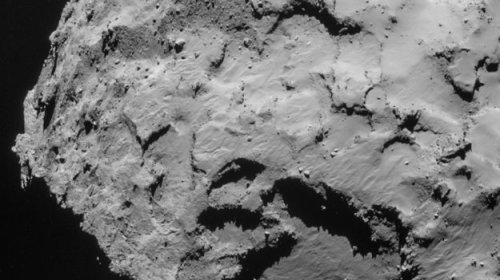
(Philae’s landing site – Photo Credit: ESA/Rosetta et al)
The European Space Agency have announced that the Rosetta spacecraft will deploy its lander, Philae, to the surface of Comet 67P/Churyumov–Gerasimenko on November 12.
Philae’s primary landing site, known as Site J, is located on the smaller of the comet’s two ‘lobes’. The lander’s backup site, Site C, is on the larger lobe. The areas were selected as the favourite candidates just six weeks after Rosetta arrived at the comet on 6th August.
Site J was chosen unanimously over four other sites as the primary landing location because there are relatively few large boulders and the majority of terrain, within a square kilometre area, has slopes of less than 30º relative to the local vertical (thus reducing the chance of Philae toppling over during landing).
The area also receives sufficient daily illumination to recharge Philae and continue surface science operations beyond the initial 64-hour battery-powered phase.
Over the last two weeks, Rosetta’s flight dynamics and operations teams have been creating detailed flight trajectories and timelines for Rosetta to deliver the lander at the earliest possible opportunity.
Two robust landing scenarios have been identified, one for the primary site and one for the backup, and both anticipate separation and landing on 12 November.
 (The location of Philae’s primary landing site – Photo Credit: ESA/Rosetta et al)
(The location of Philae’s primary landing site – Photo Credit: ESA/Rosetta et al)
If the craft’s mission team decide to target the primary landing site, Rosetta will release Philae at 8:35 a.m GMT (4:35 a.m EDT) at a distance of 22.5 km from the centre of the comet. Philae is expected to land about seven hours later. The one-way signal travel time between Rosetta and Earth on 12 November is 28 minutes 20 seconds, meaning that confirmation of the landing will arrive at Earth ground stations at around 16:00 p.m GMT (12:00 p.m EDT).
If a decision is made to use the backup site, separation will occur at 13:04 p.m GMT (9:04 a.m EDT) at around 12.5 km from the centre of the comet. Landing will occur about four hours later, with confirmation on Earth recieved at around 17:30 p.m GMT (13:30 p.m EDT).
Final confirmation of the primary landing site and its landing scenario will be made on 14 October after a formal Lander Operations Readiness Review, which will include the results of additional high-resolution analysis of the landing sites conducted in the meantime. Should the backup site be chosen at this stage, landing can still occur on 12 November.
You can learn more about Philae’s descent and landing onto comet 67P below:
[Video Credit: ESA]